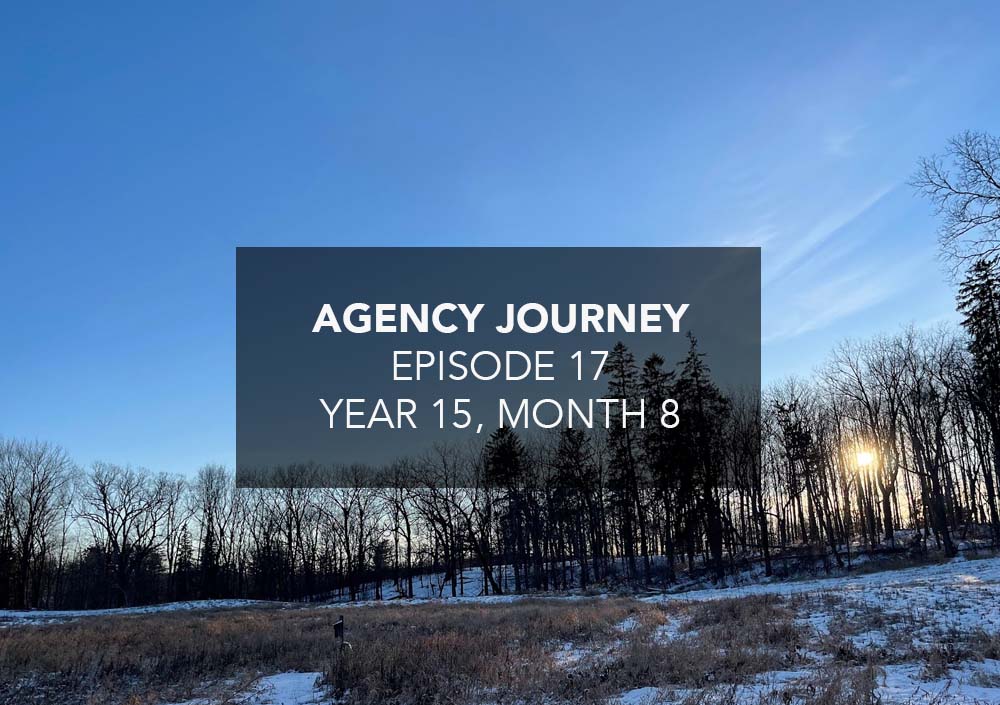Every now and then, I’ll take screenshots of meeting agendas and notes from exactly 1 year, 2 years, and even 3 years ago and share it with my partners. Part of the exercise is to show how similar themes pop up over and over again, but the more important reason is to reflect on how our understanding of certain topics has evolved and deepened over time. We often cringe at the shallow, surface-level understanding of topics from previous years. We also tell each other that if we’re doing it right, we ought to feel the same way about today’s notes this time next year.
About Agency Journey: This is a monthly series detailing the happenings of my agency Barrel, founded in 2006. You can find previous episodes here.
Highlights
New Business Wins & Outbound Action
We ended December with some promising signs for new business and these turned into real engagements in January. One is a fast-growing shoe brand that has a great following in the skateboarding community. Another one is a purveyor of high-end strawberries. And we welcomed back a women’s wear client from the past. The pipeline activity has been robust, and we’re hoping to land a few more deals in the coming weeks.
We also officially started up our outbound campaigns with a 3rd party lead generation service. The initial results have been very promising–we’ve already had calls with several prospects and it hasn’t even been a month yet! I think the main difference with this particular vendor is their expertise in email deliverability and sourcing lists of relevant targets. If we can convert even just a handful of these leads, the investment will have been well worth it.

I’ve been pleasantly surprised by the lead volume coming from our outbound campaigns. These are legit opportunities with some recognizable brands. While closing an outbound lead is always a challenge, the number of opportunities is a great improvement from our previous attempts with outbound.
One thing we’ll need to figure out in the coming months is how best to nurture and warm up some of these initial outbound leads. We may need to leverage our CRM to do some lead scoring, enter people into drip campaigns, and develop a system for periodically checking in with contacts. This is uncharted territory for us because we’ve mainly focused on inbound leads for the longest time, but I’m excited to experiment with different approaches.
Team Attrition Setbacks & Q12 Worries
Team attrition has been a drag, and we’re dealing with the fallout. In a span of a few weeks, we lost a senior designer, our resource manager, our talent acquisition manager, and a software engineer. We’ve tried to learn from each departure and have been finding ways to fill the gaps in the short-term. In the case of our resource manager and talent acquisition manager, we’re re-evaluating the roles and trying to see how how best to go about handling the responsibilities of those roles in the long run.
Related to this, I also saw that our quarterly engagement survey results, which consist of 12 questions modeled after the Gallup Q12, showed declines across the board. For example, we scored nearly 35% worse on “In the last seven days, have you received recognition or praise for doing good work?” which means we haven’t done a great job of showing appreciation for team members. Another worrisome one was a near 38% lower score for the question “In the last six months, has someone at work talked to you about your progress?” We’ll have to look deeper and try to understand why these lower scores are happening and what we can do to improve them.
Annual Planning Meetings
I ran two planning meetings in January, one for our Team Leads (11 people) and another one for the Barrel partners (4 people).
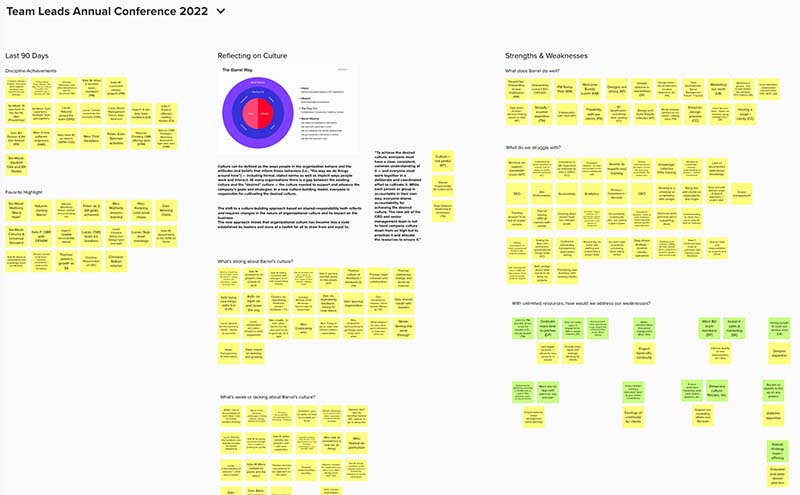
A snapshot of things shared at our Team Leads meeting. There were some healthy discussions around culture but we lost steam when talking about strengths/weaknesses. I think there was too much overlap there and focusing on culture might have been enough for this type of meeting. The post-meeting survey score was poor & very critical, which means making some smart tweaks for the next one.
The Team Leads meeting started off great with discussions around Barrel’s culture, but it ran out of steam towards the end. I could have done a much better job of moderating the meeting to keep the pace going, but the bigger problem was in how I structured the meeting to begin with. The meeting could have been shorter and some of the prompts I asked people to prepare could have been different. For example, I had high hopes for the question “If you had unlimited resources at your disposal, how would you solve for the areas we are struggling with?” but the discussion fell flat and many of our team leads had a tough time wrapping their heads around this.
I sent out an anonymous survey after the meeting and got some low marks as well as some well-deserved criticism of the meeting format and outcome. I’ll do better next time.
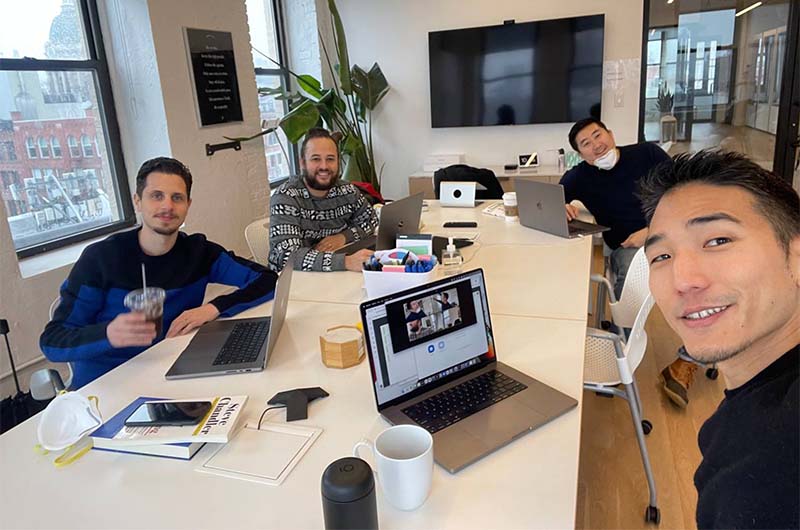
The Barrel partners met in-person at the Barrel NYC office for our Q1 2022 planning meeting. You can see that we had Zoom up even though we were in person since we did our “whiteboarding” on Mural.
Our Barrel partners meeting, on the other hand, was very productive and highly energizing. We shared our takeaways from two books – The Joy of Selling by Steve Chandler and The Cold Start Problem by Andrew Chen, and talked about how certain lessons could be applied to Barrel. We then dove into sharing and stress-testing each others’ top two initiatives for Q1 2022. We clarified the outcomes for each and also raised questions that we would need to address in the coming weeks. To have clear takeaways and items to work on for the rest of the quarter felt really productive.
Wes flew in from Atlanta, Lucas drove in from Pennsylvania, and Sei-Wook from New Jersey as we met at the deserted Barrel office (omicron precautions). I took the short commute from Brooklyn and we enjoyed the rare in-person get-together.
Top of Mind
Simplifying the Business with Key Metrics
Like any other year, we set revenue and profit goals for 2022. What we hope to do differently this year is to do a better job of defining a set of key metrics that can give us a more accurate sense of our business performance on a week-to-week basis and stay on top of them by understanding the activities and behaviors that impact the numbers. I’ll share three below that are top of mind for me this month.
Utilization
One of the metrics is utilization. We’ve struggled to make this metric stick in the past, but we’ve come up with a simpler way to track and a clearer way to show our team leads how the utilization of each team contributes to the company’s business performance. Each team will have a weekly billable target based on the team makeup and team leads will be responsible for ensuring they can hit this mark. We’ll keep close tabs on cases of over or under-utilization across teams, giving us the data necessary to either hire more people for that team or right-sizing the team with layoffs. We’ve been fairly loose with keeping underutilized resources in the past, but having accurate data will give us the confidence to make tough decisions if we need to. Likewise, if there are teams that are continually overclocking on billable work, we’ll be quick to provide support with contractors or additional hires.
Sales Pipeline
Another metric is the weighted size of our pipeline, which gives us an idea of how busy we’ll be in the coming months. We have enough data at this point to feel more confident about the way we weight the deals across various stages. For qualified deals with new prospects that are in the proposal stage, we assign a weight of 30%, so a $100,000 project will be valued as $30,000 in the pipeline metric. For proposals that are sent to existing clients, we weigh them at 50%, so a $100,000 project will count as $50,000. Deals that enter contract negotiation stage is marked up to 80% and only when a deal is signed and invoiced do we count it as 100%.
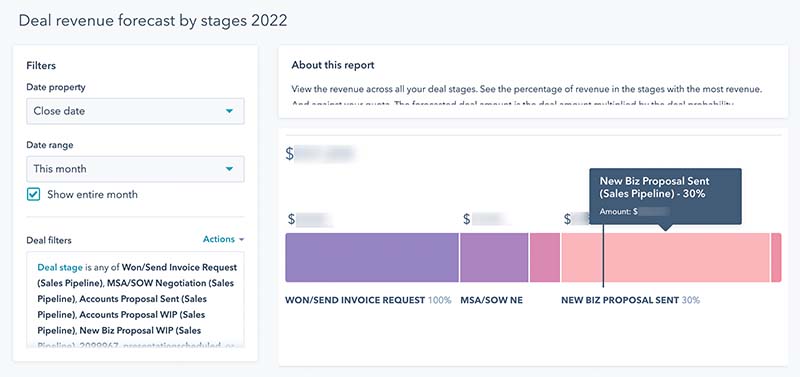
A screenshot of the sales pipeline module on our Barrel Business Development Dashboard. These reflect the weighted values of the deals in the pipeline included 30% for any proposals sent.
The pipeline number requires many inputs and we’ve set up our dashboards to closely monitor some leading indicators. These include: number of leads per week, number of calls per week, number of proposals sent per week, and the average value of the deals. We’ve worked back from our revenue targets and used historical data on average deal size, win rate, leads to call rate, and calls to proposal rate in order to figure out how many leads we need per week to keep pace. It’s not an exact science, but it provides us with some targets to aim our marketing and sales efforts.
Monthly Recurring Revenue
One of the things that hurt us last year was the loss of key retainer accounts that eroded our monthly recurring revenue base. The client churn took away revenue predictability and left us scrambling to fill the holes. Even in the early weeks of 2022, we were blindsided with a sudden termination of a sizable retainer contract, which put an immediate dent on our 12-month projections.
We’ve been focusing a great deal of attention to stabilize and strengthen our existing client relationships and to have better processes and strategies for retaining new clients. This includes being proactive with recommendations to improve website performance or surfacing compelling features and user interactions that could help our clients differentiate from their competitors. The goal for us is to steadily increase our monthly recurring revenue (MRR) and to actually turn most of these into longer-term annual contracts. While we’ll never have a purely MRR business like a subscription-as-a-service (SaaS) business, we think the majority of our revenue can come from recurring revenue contracts.
I’ve been devoting time to figuring out how we can best package and sell value-add services into existing accounts. It’s not too hard to identify and surface opportunities that can greatly benefit a single client, but what’s challenging is doing this consistently across all the accounts and delivering strategic guidance with real measurable results. We simply haven’t invested enough in an infrastructure that can do this reliably without stretching a few key individuals very thin. The opportunity for us is to better train the team and be more diligent about developing repeatable processes vs. being purely reactive to client requests. Getting this right will help us grow recurring revenue.
Shared with Partners
“You can be the smartest, most well-liked, most hardworking manager in the world, but if your team has a long-standing reputation for mediocre outcomes, then unfortunately you can’t objectively be considered a ‘great’ manager.” (Julie Zhuo, The Making of a Manager)
This one hits hard because I often think that our outcomes as a business have been mediocre and that’s a reflection of my shortcomings as a manager. I still believe there’s time to change the narrative.
“Structure determines behavior. The way anything is structured determines the behavior within that structure.” (Robert Fritz, The Path of Least Resistance)
The departure of our resource manager earlier this month led to a deeper dive into how we were doing resourcing at the company. It looks like in a short period of time, we created some overly complex structures that tended to create more friction although with good intentions. We were very hopeful last year about establishing resourcing as its own discipline, but for now, we’ve gone back to having our account and project leads manage their own resourcing needs.
“Rather than fixate on external risks, we will look inward to examine the factors that are so ubiquitous that we cease to see them, and so stubbornly enduring that we too often accept them as constants, rather than as variables we can affect.” (Stanley McChrystal and Anna Butrico, Risk)
Great reminder that most risks are embedded in the way we do things and especially in our blindspots that have been calcified by years of ignoring unthinkable worst-case scenarios. An example: last year, we got much better about IT security across the org (OneLogin) and about managing access to client-related website accounts, but for years, this was a risk we tolerated and gave little thought to.
“Without coaching and consequences, critical drivers and outcomes will become suggestions, not standards.” (Keith J. Cunningham, The Road Less Stupid)
Part of the drive to simplify the business with key metrics is to keep ourselves accountable and to ensure that our team leads are performing to measurable standards. This may seem like a tougher and colder approach on the outside, but I think the clarity and focus will be welcomed.
“When there is trust, conflict becomes nothing but the pursuit of truth, an attempt to find the best possible answer. It is not only okay but desirable. Conflict without trust, however, is politics, an attempt to manipulate others in order to win an argument regardless of the truth.” (Patrick M. Lencioni, The Advantage)
If I’m being honest with myself, I think I’ve built great trust with my Barrel partners but there’s much work to be done in establishing trust with the rest of the company. Many people are new and still feeling their way around. Some have not felt great about the company for various reasons. There’s much to do to keep building credibility with others, and I just need to keep showing up every day.
We Launched a New Portfolio Company
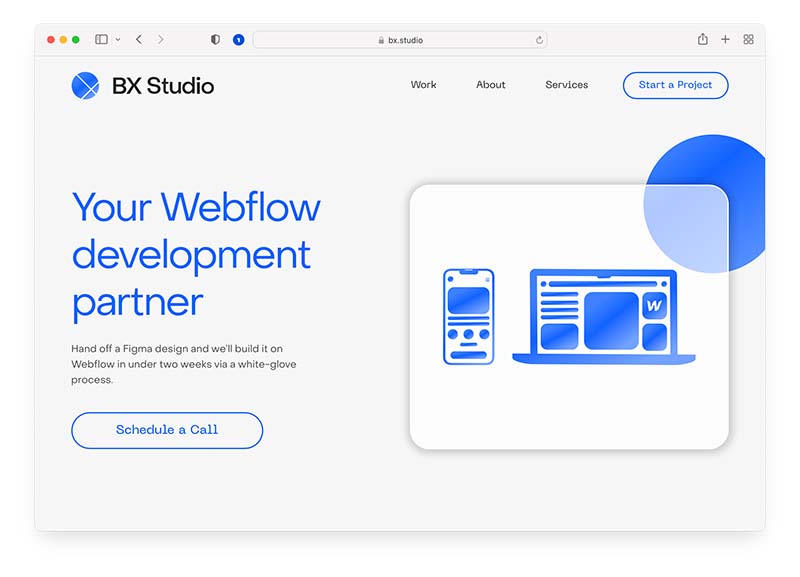
BX Studio provides Webflow development services to agencies and startups that have their own designs. We also have a “10-Day Website” offering for SMBs and very early-stage startups.
Amid all the hectic ups and downs of running Barrel, we launched a new agency business under the Barrel Holdings umbrella. It’s called BX Studio, and we’re focused on helping companies build their websites on Webflow, a popular website-building platform that designers love because of its ability to enable rich user experiences without coding (“no-code”). The business will focus on two areas to start:
- Webflow development for other agencies (Barrel is an early customer) and startups with designs ready to be turned into Webflow websites
- A 10-Day Website offering for startups and small businesses that want to forgo the traditional website design process and get something done quickly, effectively, and for less cost
Running BX Studio is Jacob Sussman, a talented and energetic leader whose experience running a digital agency will be crucial as we get things going. I’ve been enjoying the collaborative process of ideating, refining, and launching the new business with Jacob, and I’m incredibly excited for what he and our Webflow Lead Dev Jim will accomplish over the next few months.
I’ll continue to keep Agency Journey mostly about Barrel as that is still my primary focus, but expect some updates occasionally about BX Studio as well as our other business Vaulted Oak, which quietly had a very strong Q4 2021 and is gearing up to have a huge 2022.
